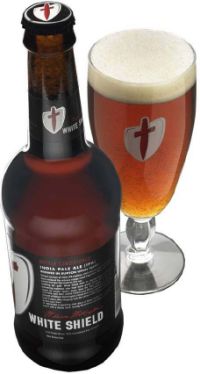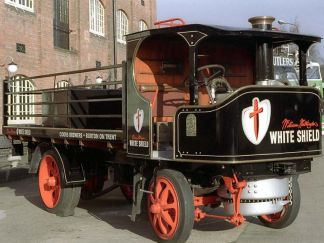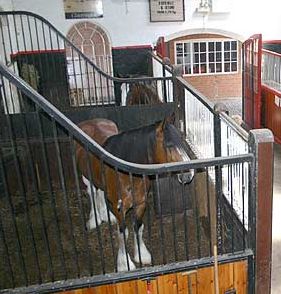 |
 |
|

|
|

|
 |
home
about
Protz
features
A-Z
books
|
|
Protz:
features
reviews
tastings
news & events
books
|

| |
White Shield: a worthy Champion
by Willard Clarke , 08/2006
Worthington's White Shield, winner of the Champion Bottled Beer of Britain award on August 1st, is not only a worthy winner of the Guardian-sponsored competition but is also a powerful link with the revolution in
brewing that took place in Burton-on-Trent in the English Midlands in the 19th century. While the first bronze-coloured "India Ale" was first brewed in London by Hodgson at Bow Bridge, it was the big
Burton brewers, including Allsopp, Bass, Salt and Worthington, who developed the style, turned it into a major export brand, transformed brewing in Britain and encouraged brewers in central Europe to
move from dark lager beers to golden interpretations.
Burton became an important brewing centre as a result of the fine water available from springs in the Trent Valley. The water is rich in such natural salts as gypsum and magnesium: salts are a
flavour enhancer and maximise both malt and hop character in beers. It was in Burton that brewers were able to use the pale malts made available by new malting techniques at the turn of the 19th
century to fashion a style of beer that was radically different to the brown ales, porters and stouts that had dominated the 18th century.
|
|

|
India Pale Ale, as the name implies, was first brewed for
the British colonies, but a weaker version called pale ale was developed for the British market and became the first national brands with the aid of the fast-growing railway system. The official historians of
British brewing, Gourvish and Wilson, called pale ale "the beer of the railway age".

|
|
William Worthington was one of the leading Burton brewers. He carved out a different path to his competitors by concentrating on bottled beer production, though the company's draught pales
should not be ignored. They were labelled simply A,B,C etc, and it was Worthington 'E' in keg form that became a major Bass brand in the 1970s. Bass and Worthington merged in the 1920s but
White Shield retained its clear identity as a bottled product and one that was 'live' at a time when most brewers were moving to filtered and pasteurised packaged beers.
|
In the 1960s and 70s, when many brewers were phasing out cask-conditioned ales in favour of keg beer, White Shield became a cult beer for aficionados. In the 1990s, when Bass began to lose interest in
sedimented beers in cask and bottle, White Shield was sidelined and moved to smaller breweries within the Bass empire before ending up at King & Barnes in Sussex. When Bass sold its breweries to the
American brewing giant Coors there were fears the beer would disappear completely but it was taken back to Burton and brewed in the small Museum Brewery. This is part of a complex that traces the
history of brewing in Burton. The brewery, run by Steve Wellington, is the former pilot brewery from the Mitchells & Butlers plant in Birmingham. At first production was a negligible 300 barrels a week but
that has grown to around 1,000 and the bottle has been given new labels that stress the heritage of Burton and India Pale Ale.
White Shield (5.6%) is brewed from pale malt with a touch of crystal for colour and flavour. Its colour rating is 26, making it quiet dark for the style. The hops are Challenger, Fuggles and Northdown, which
create 40 units of bitterness. Challenger and Fuggles are copper hops used for bitterness, with Northdown are added at the end of the boil for aroma.
Following primary fermentation, the beer is conditioned in bulk for three weeks and is then bottled with a "sticky" yeast - a different strain to the one used for the first fermentation. The sticky yeast sinks to the
bottom of the bottle where it continues to turn the remaining malt sugars into alcohol and carbon dioxide.
This wonderfully enticing and complex beer has spices, peppery hops, apple fruit and sulphur on the nose - apple and sulphur are characteristics of Burton beers - with juicy malt, tart and tangy hops, hop
resins and spices in the mouth. The lingering finish has a bitter hop note balanced by rich biscuity malt and apple fruit.
Right: the shires at the Coors visitor centre.
|
|

|
The beer will improve with age. A Bass brewer once explained to me that after around nine months the beer goes through a "sickness period" when it goes out of condition and then returns in drinkable form. I
once laid a bottle down for 10 years and when opened it was darker and fruitier with a more muted hop bitterness than a young version. Either way, this iconic beer is one to savour and marvel at.
White Shield is available in Booths, Sainsbury's, Tesco and Waitrose. Further information from Coors on 01283 511000 and www.worthingtonswhiteshield.com
|
|
home
about
Protz
features
A-Z
books
|





